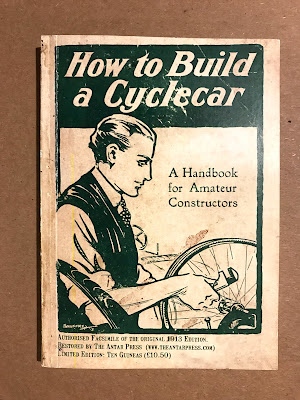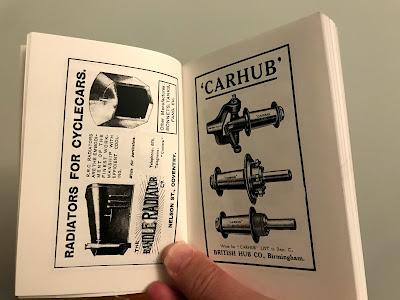 |
| My favourite old car book. |
Before the days of the Ford Model T, cars were expensive and there was a gap in the market for small, lightweight and cheap vehicles to take advantage of the gap in the market between motorcycles and big expensive cars. There were hundreds and hundreds of cyclecar manufacturers around the world, Some barely lasted long enough to produce a car, other names like Bedelia, GN, and Morgan became automotive legend. But when the time the Model T came to the market the cheap mass produced car killed the cyclecar market.
History lesson over. What about the book?
The book describes in great detail how to build your own cyclecar. It gives you a full list of the wood,(ash is the preferred material for the chassis), tools and ironmongery that you'll need to build your own vehicle. The language and attitudes of the time are a charm. You are told what work you should get done by a blacksmith and it is suggested that if you don't have a coach-house available to store the project you should consider a small rental garage. The term "coach-house" (or carriage house) would indicate that the prospective builder might be slightly well to do.
 |
| This spread of pages discusses the advantages of wood over iron and steel, and even presents you with a cutting diagram for the chassis. |
Manufacturers of parts that it would be beyond the prospective builder to make are suggested. Several models of suitable engines are also discussed. Nothing is overlooked.
In fact the project is described in such detail that if I could find Chater Lea gears, Skefco bearings and a Stag cyclecar engine, I'd probably have a go myself.
As this is a facsimile of the original all contemporary adverts are included. These are just as wonderful as the construction text. Advertisements from Chater Lea, Blenheim bodies and a Drummond Lathes for example.
 |
| Period advertisements are as much a part of the book as the text. |
No comments:
Post a Comment